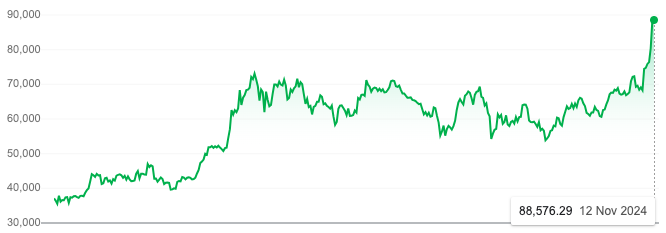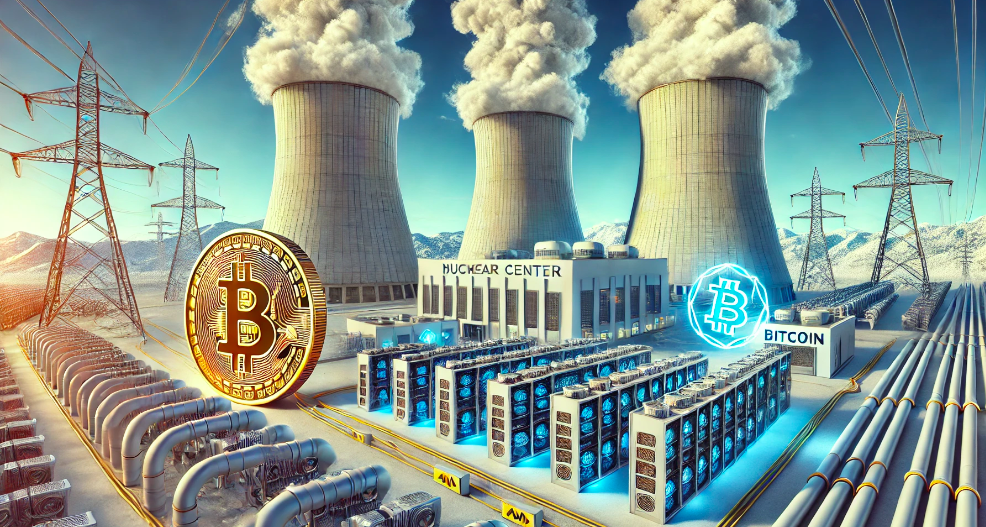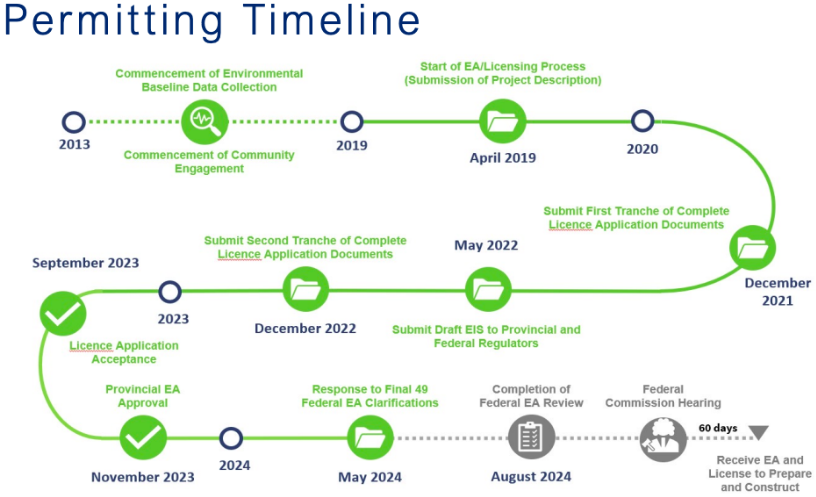The rising energy demands of Bitcoin mining have prompted a global search for stable, low-emission power sources. Among the alternatives, nuclear energy has emerged as a potential game-changer, offering a steady, high-capacity supply with minimal environmental impact. Unlike other sources, nuclear energy provides a continuous output, independent of weather conditions, making it particularly suitable for energy-intensive operations like Bitcoin mining.
Bitcoin Nears $90,000, Eyes Set on the $100,000 Mark
Bitcoin surged to impressive new highs this week, nearing the $90,000 milestone. On Monday night, the cryptocurrency was trading at $89,100, up 12% for the day, according to Coin Metrics, and even touched an all-time high of $89,623. This bullish momentum is fueling investor optimism, with many speculating that Bitcoin will reach the much-anticipated $100,000 level by year’s end.
“Bitcoin is now in price discovery mode after breaking through all-time highs last Wednesday, following Trump’s election victory,” noted Mike Colonnese, an analyst at H.C. Wainwright. The analyst predicts that strong positive sentiment will persist throughout 2024, potentially propelling Bitcoin past the six-figure threshold.

Why Nuclear Power Works for Bitcoin Mining
- Environmental Sustainability: Nuclear power generates minimal greenhouse gases compared to fossil fuels. This appeals to both industry stakeholders and regulators who are concerned about Bitcoin’s environmental footprint. As the carbon impact of Bitcoin mining faces scrutiny, nuclear energy provides a cleaner, more sustainable option that can help align the industry with environmental goals.
- Stability and High Capacity: Bitcoin mining demands constant power to run the computational algorithms required for transaction verification and block creation. Nuclear power plants offer an uninterrupted supply of energy, unlike solar and wind sources, which are inherently variable. This stable energy source is ideal for mining operations that require consistent power to maximize uptime and efficiency.
- Cost Efficiency in the Long Run: Although nuclear plants require a significant initial investment, the long-term cost of nuclear power generation is relatively low. Large-scale mining operations benefit from this stability, as it protects them from the volatility of energy prices associated with other power sources. For these businesses, nuclear energy could mean reduced operational costs over time.
- Utilization of Existing Infrastructure: Many nuclear facilities, especially those operating below full capacity, have unused energy that could be redirected to mining operations. This provides an efficient use of resources for nuclear plants and a steady power supply for miners. Additionally, in remote areas with fewer alternatives, nuclear power can support local economic growth through partnerships with Bitcoin mining companies.

Real-World Examples: How Nuclear Power is Supporting Bitcoin Mining
United States: TeraWulf’s Partnership with Energy Harbor
In the U.S., TeraWulf, a Bitcoin mining company, has made strides in incorporating nuclear energy into its operations. In 2022, TeraWulf partnered with Energy Harbor Corp. to build a zero-carbon Bitcoin mining facility in Pennsylvania. This facility, powered by a local nuclear power plant, demonstrates how the Bitcoin industry can leverage atomic energy to mitigate environmental concerns while securing stable power. By sourcing energy from a nuclear facility, TeraWulf’s Pennsylvania operation is projected to run on 100% carbon-free energy, marking an essential milestone in sustainable mining.
Canada: Nuclear-Powered Mining Initiatives in Ontario
In Canada, Bitcoin mining companies are exploring partnerships with the nuclear sector, particularly in Ontario, where nuclear power is a significant part of the province’s energy grid. Ontario Power Generation (OPG), the largest nuclear power producer in the province, has expressed interest in clean energy partnerships, including the potential for supplying power to Bitcoin mining operations. By tapping into Ontario’s nuclear infrastructure, mining operations could leverage the abundant, low-cost, and carbon-neutral power available in the region. Canadian companies are well-positioned to support nuclear-powered mining, as existing nuclear infrastructure provides an opportunity to create sustainable, long-term energy solutions tailored to high-demand industries.
Emerging Interest in Small Modular Reactors (SMRs) for Mining
One of the most innovative developments in nuclear energy applications for Bitcoin mining is the exploration of Small Modular Reactors (SMRs). Unlike traditional nuclear reactors, SMRs are designed to be more flexible, cost-effective, and easily deployable. This modular approach can provide a decentralized and adaptable energy source specifically suited to the needs of Bitcoin mining. SMRs are appealing for remote locations or facilities that require compact power solutions. For instance, Canadian energy company Ontario Power Generation is working on deploying SMRs, and NuScale Power, a U.S.-based nuclear technology company, is leading efforts to commercialize SMRs for various industrial applications, including Bitcoin mining.

NexGen Energy: A Leader in Uranium Development with Strategic Advantages
NexGen Energy (NXE), founded in 2011, has swiftly become a prominent figure in uranium exploration and development. The company’s flagship asset, the Rook I Project in Saskatchewan’s Athabasca Basin, stands as one of the world’s most promising uranium projects under development. Located in a region renowned for its rich mineral deposits, NexGen’s achievements in exploration have drawn considerable attention from both investors and industry analysts.
The Rook I Project’s potential to produce nearly 30 million pounds of uranium annually makes it a pivotal asset, poised to supply over 50% of the Western world’s uranium. Positioned in a Tier 1 mining jurisdiction and offering high-grade deposits on a large scale, NexGen is positioned as a key player in the future of uranium supply.

In 2024, NexGen reported a major discovery in Hole RK-24-207 within the Patterson Corridor East. This drilling intersected a continuous 50-meter zone of high-grade uranium mineralization, with intervals grading an impressive 6.5% U3O8 over 25 meters. This finding expanded the mineralized zone by around 30%, bringing the project’s estimated resource potential to over 350 million pounds of U3O8. These results reflect NexGen’s expertise and bolster its capacity to meet rising global uranium demand.
In addition to exploration achievements, NexGen has updated the financial forecasts for the Rook I Project. The revised economic model estimates a net present value (NPV) of approximately $5 billion and an internal rate of return (IRR) exceeding 50%, supported by the increased resource base and favorable market conditions. Over a 10-year mine life, the project is expected to generate $19 billion in economic impact.
NexGen Energy (NXE) has attracted significant analyst interest, with a prevailing bullish outlook. Analysts currently place an average price target at $9.57, with price estimates ranging from a high of $15.34 to a low of $7.31. Out of 15 analysts, 13 have rated NexGen as a “Strong Buy,” and 2 as a “Buy,” underscoring high confidence in the company’s future performance. With these positive ratings and promising projections, NexGen Energy is considered a strong investment choice, offering compelling exposure in the uranium market for those looking to capitalize on the sector’s growth potential.
Marc has been involved in the Stock Market Media Industry for the last +5 years. After obtaining a college degree in engineering in France, he moved to Canada, where he created Money,eh?, a personal finance website.

